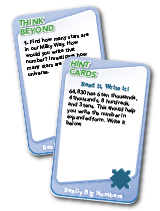Search Listing Name

product:
Journeys and Destinations Teacher Guide + 1 Year License
For grades 2-3, this unit provides an opportunity for students to recognize that change affects people and their relationships, as well as the world around them. The unit activities engage students in discussing and writing about what they have read, and in independent and group learning opportunities that promote skill development in vocabulary, persuasive writing, literary analysis, oral communication, and thinking. Discussion emphasizes the search for meaning in literature.
product:
Project M3: Level 5-6: Designer Boxes: Exploring Volume and Surface Area Teacher Guide + 3 Year License
In this unit on geometric measurement, students build on the work they have done with area and per

product:
IM v.360: Grade 5 Spanish Teacher Guide Set
IM® v.360 K-5 Math is an IM Certified curriculum providing trusted, highly rated materials to ensure students thrive in mathematics. Each Illustrative Mathematics lesson has four phases, from pre-unit practice modules to cool downs, focusing students’ attention on definitions, notations, and graphical conventions contributing to the development of real numbers.
Grade 5
The big ideas in grade 5 include: developing fluency with addition and subtraction of fractions, developing understanding of multiplication and division of fractio
product:
OpenSciEd Unit 8.1: Contact Forces Student Edition
OpenSciEd Middle School science program addresses all middle school NGSS standards. This comprehensive science curriculum empowers students to question, design, investigate, and solve the world around them.
- Phenomenon Based - Centered around exploring phenomena or solving problems
- Driven by Student Questions - Storyline based on students’ questions and ideas
- Grounded in Evidence - Incremental building and revision of ideas based on evidence
- Collaborative - class and teacher figure

